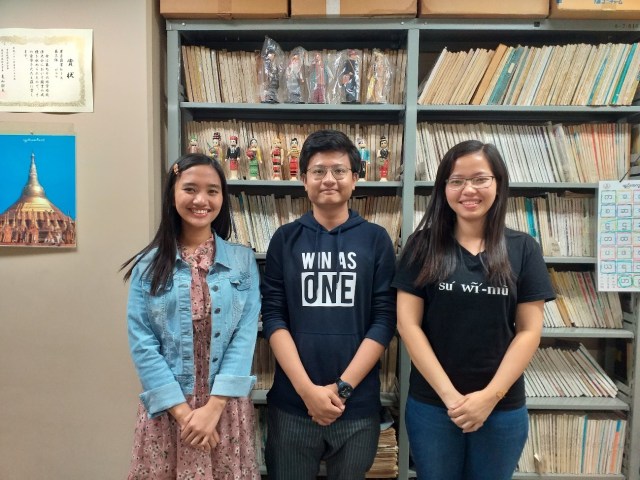2019 Activity Report
March News from the Yangon Japanese Classroom
31 March 2020
Global Japan Office Coordinator
IMAI Michiko
In February’s report, I wrote that Myanmar was “still quite relaxed”, but in March, the first reports of infected persons appeared, and Myanmar’s COVID-19 coronavirus situation developed rapidly.
The first panic occurred on March 13, when people lined up at a supermarket near the dormitory after loading large carts with piles of merchandise. I didn’t know what was going on at that time, so I looked around the display shelves and noticed the rice shelf was empty. Most of the delicious Paw San (Fragrant Rice) was sold out, and only the slender Indica rice remained unsold. Cooking oil, which is very important to Burmese people, is usually sold in tanks containing a few liters on the bottom shelf, but it was sold out. A caucasian guy in front of me at the cash register bought two carts worth of supplies, including diapers, meat, cheese, toilet paper, kitchen paper, etc., for a total of 620,000 kyats (About 46000 yen.).
After that, it calmed down a bit, but the number of people wearing masks gradually increased, with about 40% of people wearing them at a big luxury shopping center I visited last week. When the second buyout panic occurred, the supermarket set a limit on the number of items that could be purchased per person. One of the pictures below shows the popular Paw San, but it has a note saying “up to 3 pieces per person”.
I went to Yangon International Airport for some errands on the 27th, but there were no counters available, and half of the airport’s departure lobby was dark with the lights down, the counter with the lights on was empty, and it felt like it was closed, so I was worried and sad about how long it would be open for if things remained like this. There was a notice about corona virus on the electric bulletin board, so I was looking at it and saw something that caught my eye. “NO SPITTING In Public”. My melancholy was gone in an instant, and I happily took pictures. Unfortunately, only those who come to the airport will carry out the instructions on this board. When I was waiting for the airport bus on my way home, the man in charge of the bus stop, with a radius of about 50 centimeters from me, was chewing some betel and spat out red saliva. I wanted to scream out GYAAAAH! Stop it! It will get on others! I was only wearing a cloth mask. If this man was already infected, I will definitely develop the virus in 2 weeks.
After all, despite the silly electric sign I saw, people in Myanmar, like this man, are still not aware of the danger of this situation, and are taking it easy. I hope that the COVID-19 situation will end before this idleness is gone.





February News from the Yangon Japanese Classroom
29 February 2020
Global Japan Office Coordinator
IMAI Michiko
In early February, the sun was strong and the daytime temperatures were over 30 degrees, and even though I was able to stay cool in the mornings and evenings, in late February, they also became hot.
The world is terrified by the coronavirus, but in Myanmar, things are still quite relaxed. Temperatures are only being taken in high-class shopping centers often used by foreigners and wealthy Burmese people, and are done so by pressing an instrument to visitor’s foreheads. At the luxury shopping center near the dormitory, you can just enter through baggage inspection as usual. There are now more people wearing masks than before, but it is very noticeable when you wear a mask since the overwhelming majority of people do not. Even if I wanted to wear a mask, they already sold out everywhere in February, so I can’t get any. The situation is not so dire that I can’t go out without making a handmade mask.
The pictures below show the LEVEL 1 class on the last Thursday of February. Some students have been wearing masks when they come into the classroom, but they take them off during class to practice their conversations. This was the last class taught by graduate students in the teacher-training program. They taught a fun class with a PowerPoint full of cute illustrations, and the students enjoyed the easy to understand and thorough methods of the young teachers. LEVEL 1 began with a large enrollment of 320 students, but, combining attendance from the two classes, only 68 students attended the last class in February. How many people will survive the finals in early March?
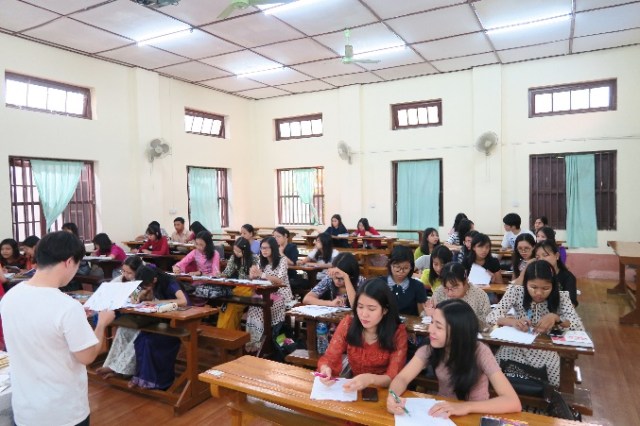
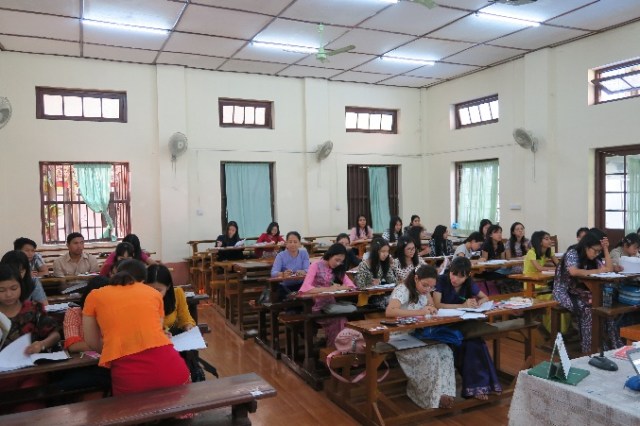
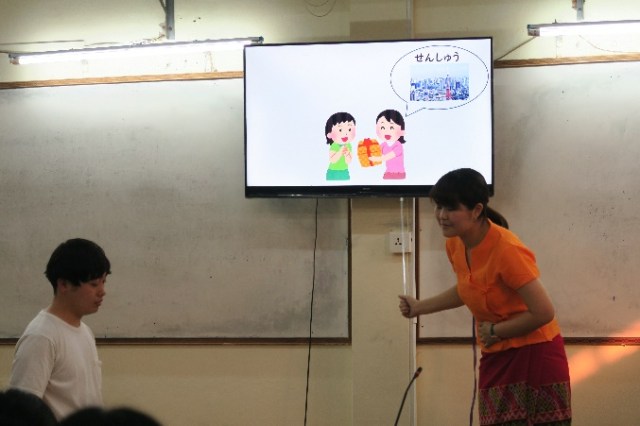
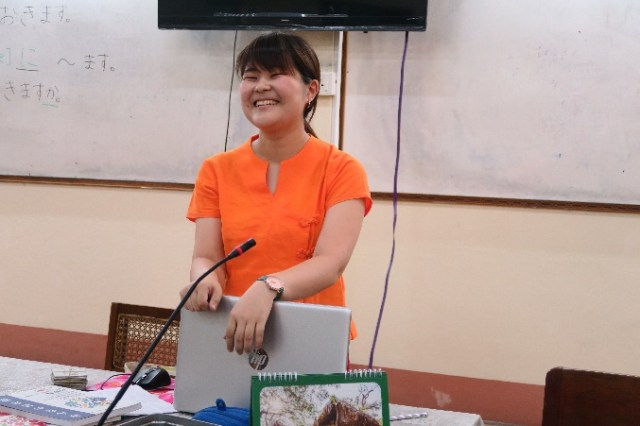
January News from the Yangon Japanese Classroom
31 January 2020
Global Japan Office Coordinator
IMAI Michiko
Happy New Year! The annual kakizome (first calligraphy of the year) ceremony was held on January 3. This year, there were only LEVEL 3 students, but 23 people participated. As usual, a graduate student of Japanese language education taught some simple basic knowledge of calligraphy and kakizome, and it was held on the 3rd.
As usual, this year I also instructed the students to write their favorite words. The students thought of their favorite words in English and Burmese and translated them into Japanese with a dictionary. Some of them used strange dictionaries, and one student even chose the word “un-nen” (lucky year). Let me introduce some words of this year’s calligraphy ceremony.
Number one was “money”. Five students wrote this word. No students wrote this last year, but this year there are five. Perhaps it is a characteristic of this class? In second place was “dream”.
Then it was “New Year” and “new”, for which the meanings are not exactly the same but use the same characters. Other than that, there were many kinds of happy words such as “good luck”, “happiness”, and so on. These are typical auspicious words of the New Year. Also, “success”, “goal”, and “wisdom” are the words that university students like to use. “Song” and “love”, were some cute choices. “Holiday” and “love” were also chosen simply because students liked those words. An interesting one was “dog”. They must like dogs. Another interesting one was “rain”, which a student chose as it is part of their name.
What kind of words would I choose? All I could think of were boring, ordinary words like “New Year’s Day”, “New Year” or “the first sunrise of the year”. I was afraid that my sensitivity was slowing down because I wasn’t thinking with excitement like my students. I shall be happy and glad in the coming year to have a fresh breeze in my stagnant brain by mingling with the students who carried their brushes in earnest, and will welcome the New Year with this in mind. I have to think of my favorite words. I hope you will enjoy this wonderful Japanese custom next year.
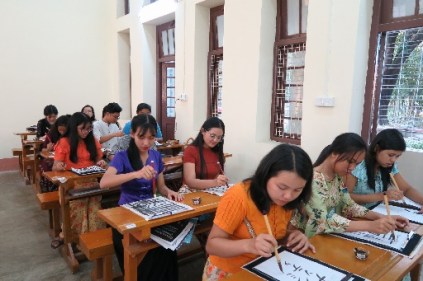
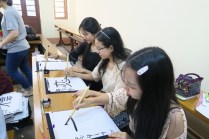

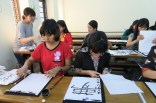



December News from the Yangon Japanese Classroom
31 December 2019
Global Japan Office Coordinator
IMAI Michiko
This year again in December, a Japanese language education graduate student of TUFS came here for practical training. On her first day at work, I went with her to make traditional clothing, longyi and eingyi.
In 2017, I was lucky enough to have a female GJO student come to my office, so I had the graduate students take me to the market, and with their help I was able to purchase a longyi. This year, the new term had just started on Monday and no one was hanging around the office. Luckily, there is a helper. Two male students from the Myanmar Language Department of TUFS and one male student from Kokushikan University, who came to Yangon University to study as an exchange student from December, interpreted for us. I decided to go with them as an attendant.
With three men and an old woman, we led a new apprentice, who looked like a princess, to the Fredan market near the university. The first floor sells perishables and household goods, but the second floor is lined with fabric stores and tailors for longyi and eingyi, and clothing accessories stores and underwear stores that sell buttons for the eingyi of jackets. In the case of longyi, beautiful cloth with various colors and different designs are hung close to the eaves of small shops or folded, and all of them are beautiful and make you wonder. I couldn’t decide which store to go to, so we went around the market a few times, and finally we chose the right one. Not only does this shop sell cloth, but the shop owner who is good at sewing also does it. After carefully measuring her size, we went to pick it up a few days later and tried it on. She became a fair-skinned Myanmar girl with a gorgeous yellow top and matching bottoms.
Like a young woman, the eingyi (jacket) is tailored to stick to the body. In this way, the line of the body cannot be faked, so a person with a good figure will look more beautiful, but if there is too much fat on the belly, the line of the fat body will be exposed. Almost 100% of young women wear these tight jackets. It is said that if you wear eingyi loosely, you will look like an old lady.
But there are quite a few middle-aged women with their rich stomachs wrapped around them, and I am always impressed by their courage and composure. As a person with a fat stomach, I always have my eingyi made not tight but with plenty of room around my stomach. The trainee wearing a tight eingyi will be teaching at the GJO until the end of February. She is young, so she may look like a student when wearing the longyi and the eingyi.
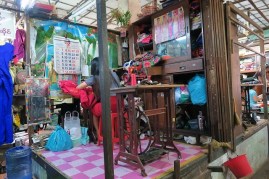
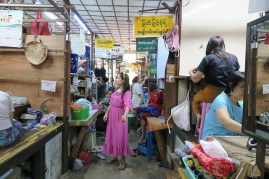
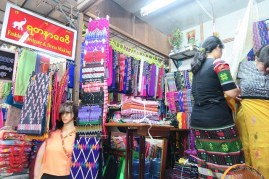
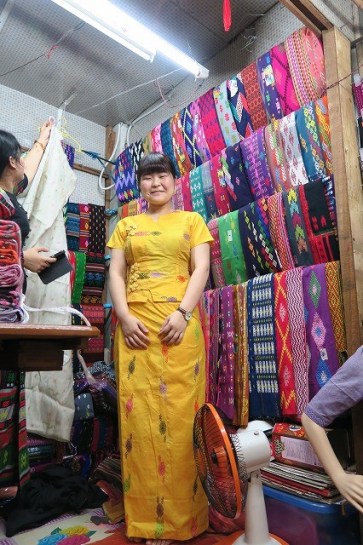
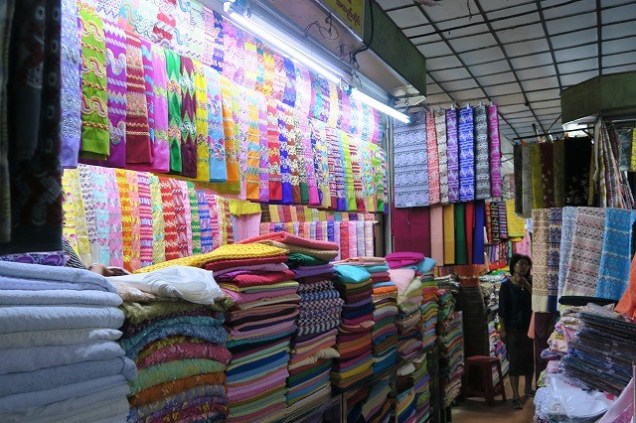
November News from the Yangon Japanese Classroom
30 November 2019
Global Japan Office Coordinator
IMAI Michiko
While returning to Japan temporarily in October, two female Japanese language teachers that live in the same dormitory as I, and one male Japanese language teacher, all of whom are teaching at the Yangon University of Foreign Languages, became Buddhist priests in November for a short period of time. One of the women and the man had their heads shaved, and the other woman did not have her hair cut and practiced as a Yogi (a practitioner of yoga and/or meditation). Two male exchange students from our university last year and a female exchange student from Osaka University also shaved their heads, and there are many others who are interested in Yogi. There are also some people who have gone into meditation training without becoming priests.
I would like to tell you a little about the ceremony of Mr. S, who became a priest for a short period in November. First of all, he was led to a building with air conditioning, and sat in front of an old monk who gave him a priest’s robe and they had a chat for a while. The old monk sat on a chair while Mr. S, a young Burmese volunteer interpreter, and three laypersons (including myself) sat on a mat on the floor. After that, he was taken by a strong young monk to wash his hair outside. With the help of the young monk, he washed his hair while wearing longyi, a type of traditional Burmese clothing. Next he sat on a chair and began shaving his head while it was still full of foam from the shampoo. After he had shaved off his hair, he went into the building again and sat down in front of the old monk. The ceremony finally began, but I couldn’t quite grasp what was going on despite listening to the interpreter speaking Japanese. Mr. S repeated what the old monk said in Burmese or Pali and received his robes. Then, with the help of a middle-aged monk, S took off his layperson clothes and put on a kasaya (Buddhist stole). After getting into his robes, S sat down again on a goza mat, and at this point, a velvety cloth was spread over his seat to distinguish him from the laypeople. I was deeply moved to see him be recognized as a monk after shaving his head, putting on a kasaya and vowing to follow the precepts. After that, the monk chanted again, S, wearing his kasaya, prayed, and the ceremony of becoming a priest was completed without a hitch.
When the interpreter translated the then precepts into Japanese, I heard precepts that were difficult for me to follow, such as “refrain from dancing, singing, music and going to see entertainment”, “refrain from eating at the forbidden time” and “refrain from wearing garlands, using perfumes, and beautifying the body with cosmetics”. Absent-mindedly, I thought that it would be impossible for me to become a priest for the rest of my life, as I was deprived of concentration by my legs which became numb from sitting on my knees.
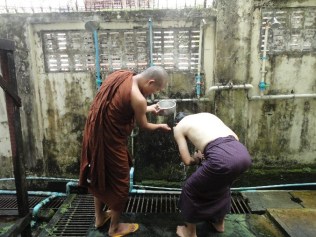
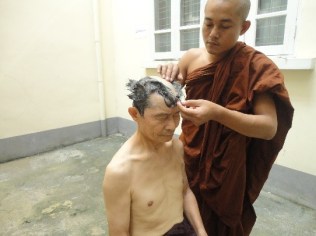
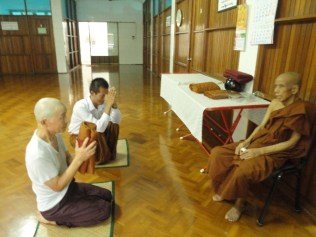
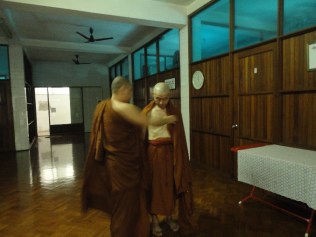
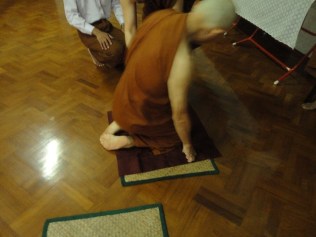
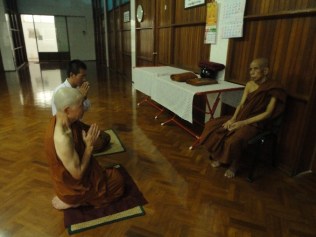
October News from the Yangon Japanese Classroom
31 October 2019
Global Japan Office Coordinator
IMAI Michiko
The 2nd term ended on September 30 and the university was closed on October 1st. There are no more classes at the GJO Yangon, so this month I will talk about the scenery of Yangon.
Over the past four or five years, Yangon has seen an increase in the number of large chain supermarkets and high-end supermarkets for foreigners and wealthy people, making it more convenient for foreigners who have difficulty speaking Burmese. However, the main shopping place for Burmese people is the local market. I’d like to introduce you to the lively “စျေးကွက်” (Zee), the Froedan Market near the university, the night market between the university and the dormitory, and the Flyin Market near the dormitory. I don’t have much to explain, but I want you to enjoy the photos.
First, please look at the picture of a market at night. This is a street stall market located somewhere between the university and the dormitory. There are stalls on both sides of the path in the side street from the main street, and there is a monastery at the back of these stalls. It’s around 6 o’clock in these pictures, and the market was crowded with shoppers on their way home from work. In the fifth photo, a woman surrounded by onions and garlic, essentials in the lives of Burmese people, works as a shopkeeper with a powder called Tanaka on her face.

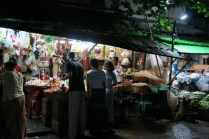
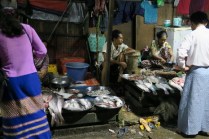
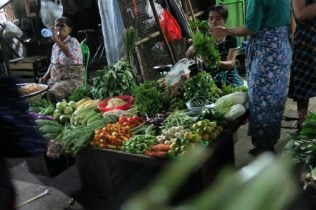
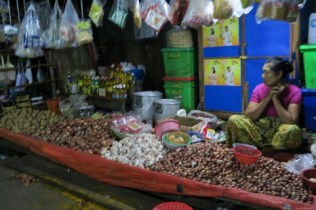
Next, I’d like to introduce you to the Flyin Market near the dormitory. This is a big market where you can find everything you need for daily life, from fresh foods and daily goods stalls to bookstores, florists, and tailors. Please take a look at one of those pictures taken from the eaves of the dry food shop. The woman in the shop is measuring onions or something by weight. It is rare to sell by weight in Yangon, so I took a picture. The other picture is of vases, kettles and rice scoops. There were also unglazed pots sold in front of that shop. They are used to give water to passers-by for free.
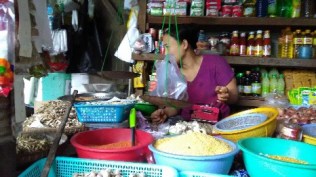

Finally, I will introduce the Frédin market near the university. Frédin Market is also a large two-story market, with a row of fabric stores, tailors, dressmaking tools and accessories on its second floor. There are many shops not only in the market building but also in the streets around it, and it is always crowded with shoppers. This time I will show you some of the flower and fruit shops. They hang pineapples, papayas and bananas without damaging them. Everything looks delicious, doesn’t it? I love passing in front of this store because it is very fun. When I looked at the brown bananas, which are not seen in Japan, or the bananas with stems full of vitality, I felt like a wild gorilla wanting to devour them.
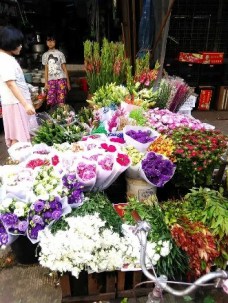
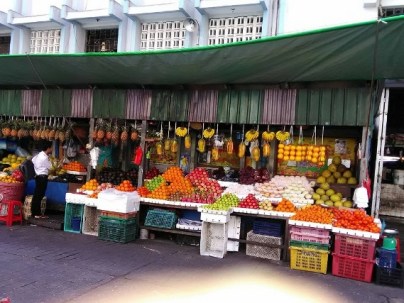

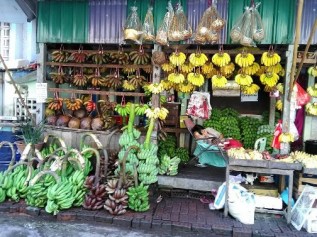
September News from the Yangon Japanese Classroom
30 September 2019
Global Japan Office Coordinator
IMAI Michiko
The annual presentation of the tandem learning project was held on September 4th. It was a big event and, due to the number of speakers, lasted over one hour and 45 minutes this year. Presentations were given in Japanese by Burmese students and vice versa. It was fairly hard for them but all groups this year did very well using clear and well-organized PowerPoint slides, which enhanced the audiences’ understanding. The topics were “Food and Culture”, “Traditional Culture” and so on as usual, but astonishingly some groups chose difficult topics such as “Climate change and disaster in Myanmar” or “Comparison of the Education Systems in Japan and Myanmar”. After the presentations, the students took photos together and were smiling with relief and satisfaction from completing their mission.
In addition, I taught the last class of LEVEL4 on September 9th, in which students gave speeches instead of final examinations. The topic was “The Most Important Thing to Me”. While worrying over preparation for the final examinations for their Majors, five students completed their speeches. Their titles were; ‘Time’, ‘Health’, ‘Happiness’ and ‘Family’. Since LEVEL4 is the most advanced class at GJO Yangon Japanese Language Course, they made interesting speeches fluently without memos. I was a little sad that I won’t be teaching them anymore, But I am also glad and proud of their achievements in Japanese over these last two years. I hope that they continue studying Japanese.
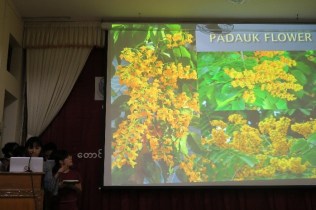
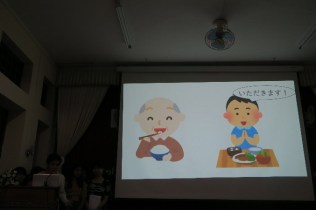
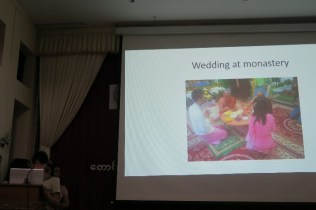
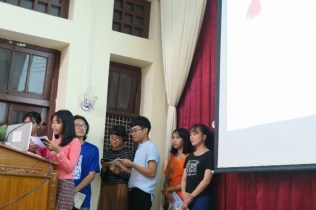
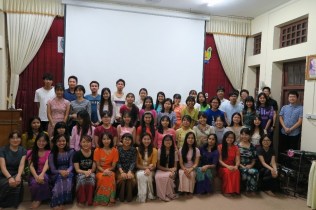
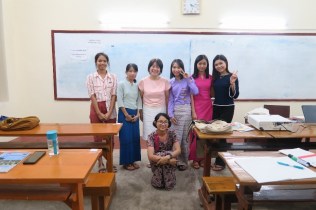
August News from the Yangon Japanese Classroom
31 August 2019
Global Japan Office Coordinator
IMAI Michiko
In mid-August, a group of students from TUFS’ Burmese department once again came to study abroad at the University of Yangon.
The orientation and group designation for the tandem learning program, during which these students will work together with Burmese students to present a research project, was held on August 21, and a discussion session about the research was held on the 28th. The students studying in the GJO Yangon Japanese Language Classroom were very excited for the TUFS students’ arrival, and a whopping 70% of the LEVEL2 class participated in the tandem learning program. Without me even telling them to do so, the students were exchanging their social media contacts and getting along wonderfully.
The photo below was taken on one of these days. A Burmese teacher from TUFS kindly took this photo.
At the end of this month, the finishing ceremony for one-year exchange students was held a little earlier than usual. All four students wore traditional Burmese clothing to the ceremony. These students helped me out a lot as assistant teachers in the December-March semester last year, during which I had over 200 students in my LEVEL1 class. They also helped me out in many other ways, such as with Tanabata preparations, and setting up new curtains in the GJO (the ceiling is 3m high, so I can’t even reach it by standing on a chair). I would like to take this opportunity to thank them for everything they did for me. Thank you very much.
August was a very lively month. Next month, the exchange students and first-year students will return home, and the Japanese classes will end not long after, so I will be a little lonely once the holiday begins.
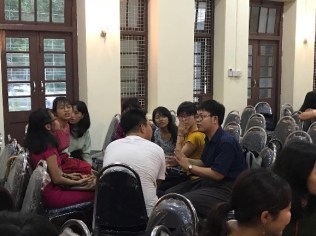
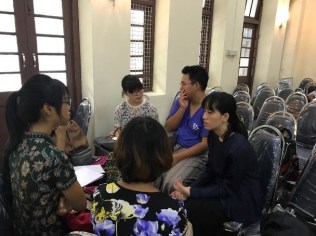
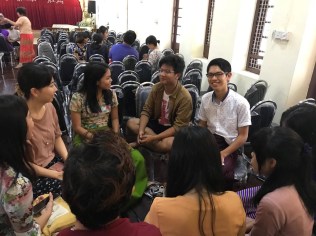
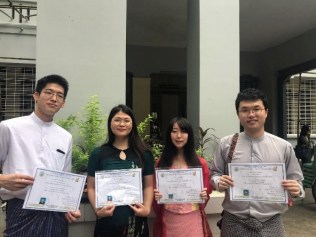
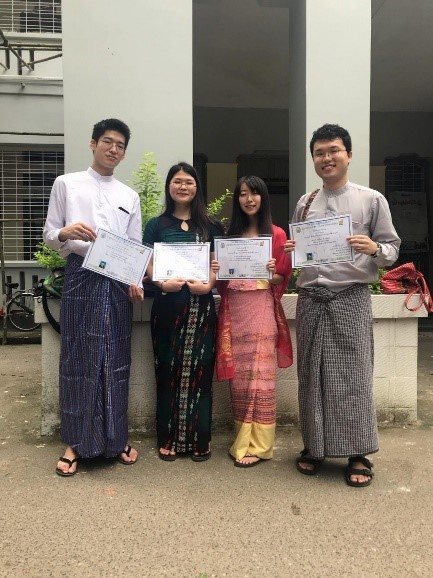
July News from the Yangon Japanese Classroom
31 July 2019
Global Japan Office Coordinator
IMAI Michiko
Tanabata season is here again. This year, I have many more students than before, so I got a bigger bamboo branch from the same place as last year. Also like last year, exchange students from the university helped me negotiate obtaining, moving and setting up the bamboo, for which I am very grateful. It was quite a large branch, but the students did a good job of setting it up, so we were able to hang the tanzaku without any issue.
Every year, the students want to write their wishes in Japanese, but this is too difficult for those in the LEVEL2 class. Up until now, I had my assistant teacher, and exchange student from TUFS, translate their wishes into Japanese, but this year there were too many LEVEL2 students, so it didn’t seem possible to write everyone’s wishes in the allotted class time. Because of this, I told the students to write their wishes in either English or Burmese. However, a few students still tried their best to write in Japanese.
Most LEVEL2 students wished for the happiness and health of their families. Aside from this, some students also wrote wishes such as “I want to go to Japan”, “I want to become good at Japanese” and “I want to get good at many languages”. Some wishes that were particularly interesting were “I am looking forward to being with you” and “I want to live with a kind person”. I thought these were quite deep. The LEVEL4 students had wonderful wishes such as “I want to be able to study in Japan”, “I wish all the wars in the world would end”, “I hope that all living beings are happy and well”, and “world peace”. The one that stood out to me from this class was “I wish to make a special memory with the person I love”. This seems to be the most likely wish to come true in the near future. One student wrote “let’s work hard together”, which I thought was quite amusing. When I asked them about it afterwards, it seems they misunderstood the sentence structure.
My wish is the same as last year’s, “I wish to be able to speak Burmese a little better”. However, I wish for this every year, so I think god is ignoring me, or perhaps I’m just ignoring my own lack of effort. Of course, it’s the latter.
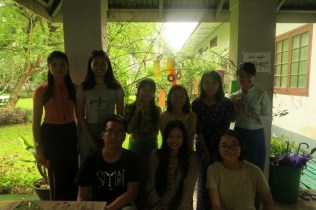
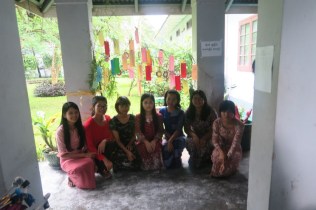
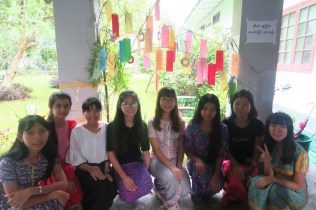
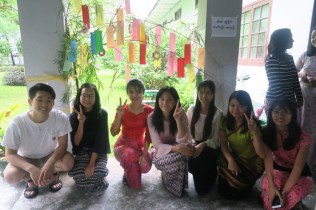
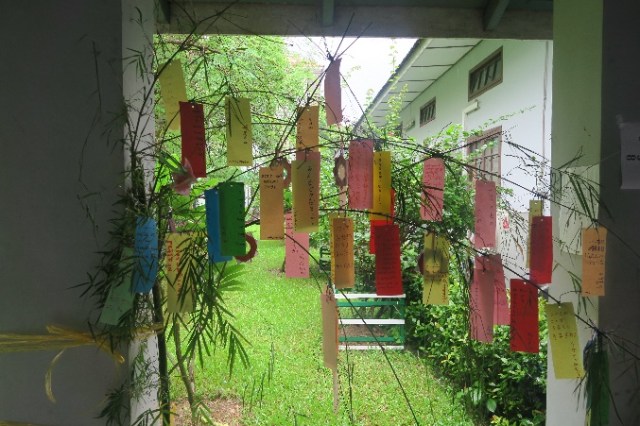
June News from the Yangon Japanese Classroom
30 June 2019
Global Japan Office Coordinator
IMAI Michiko
In June, something amazing happened that made life a lot easier. They finally put traffic lights along Inya Lake’s Pyay Road, the road that leads to the dorm for foreign teachers!
One evening I was walking along the street when I noticed something glowing and lifted my head up to see a traffic light and a pedestrian crossing! There were also new traffic lights in front of LOTTERIA, which I often visit on my way home when I want to eat something cold to escape the heat, and the supermarket I buy groceries at. On top of this, another traffic light was installed on the small road that branches off west from Pyay Road, which is none other than the road of the dormitory I live in! It’s almost as if someone installed these just for me.
With this change I hopefully won’t have to weave through cars for dear life anymore. As a resident here, I am happy that Yangon has advanced one more step forward.
The picture is of the traffic light by the LOTTERIA I regularly go to on my way home. The pedestrian symbol moves faster in the last five seconds or so, which I thought was very cute as it looks like it is trying to hurry. Sorry I can’t show you a video of it.

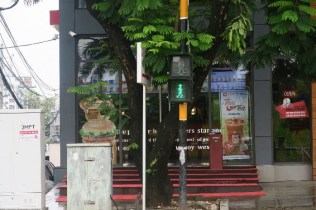
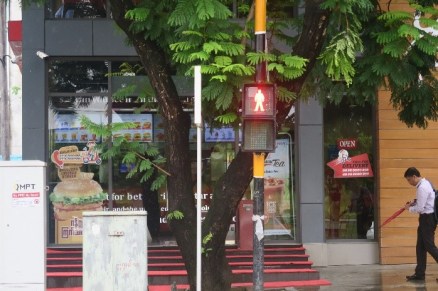

May News from the Yangon Japanese Classroom
31 May 2019
Global Japan Office Coordinator
IMAI Michiko
In May, the university is still in its vacation, so this month I will write about Yangon. If I had to describe this month in a few words, they would be “planned power outages”, “hot”, “mango”, “hot”, and once more, “mango”. This year it was considerably hotter than this time last year, and there were 2-4 hour long planned power outages every day, so you couldn’t even use air conditioning. Hotels and luxury condominiums have generators, so they didn’t have power outages, but the houses of ordinary Burmese people, and the foreign teacher’s dorm I live in, had planned power outages, during which the electricity would be suspended for two hours, which honestly felt like training to endure the flames of hell. You may think it would be better to go to an air-conditioned shopping mall or somewhere similar during a time like this, but the sun rays were honestly so intense, so even getting a taxi (walking is impossible) to the shopping center would have been far too exhausting for older people.
The rainy season finally began on May 22, and in my 20-something years in Southeast Asia, I don’t think I have ever been so happy to see it. The planned power outages continued on until the end of May, but since it was constantly raining, it was cool enough to endure the two-hour outages without air conditioning.
While I’m actually not too fond of the rainy season, there are many good things that come from it. Fruits are plentiful and very delicious during the rainy season. Mangoes are ripe in mid-May, and many other southern fruits are also in season. Last week the jackfruit and mangoes growing in the garden of my dorm were distributed amongst the foreign teachers living there. It’s a shame I didn’t take a photo.
A student from the GJO classes came to my house one morning and gave me seven mangoes she picked from a tree near her house. She called the large one on the right of the photo a “pinkaw”, and the smaller one on the left a “nozi”. A friend of mine also shared five of the mangoes she picked at her nephew’s orchard with me. The big round type on the left of the watch is apparently called “Ma Chit Su”, and the one on the right is called “Yin Kwe”. I couldn’t tell the four types apart, some just looked bigger and some smaller, but Burmese people can tell them apart just from looking at them. I suppose it’s similar to how Japanese people can tell the difference between different varieties of apples.
Apparently you can eat them once they’ve turned yellow. There’s 12 of them and one of me, so I think I’ll have to share them with someone. It seems like I’m going to have some luxurious mango-filled days. I can’t wait!
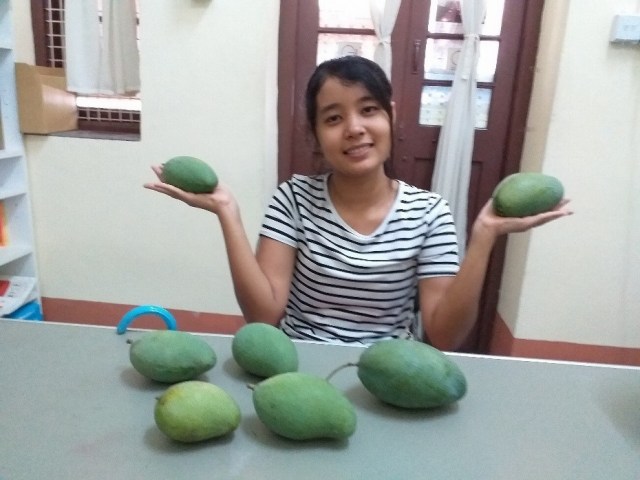
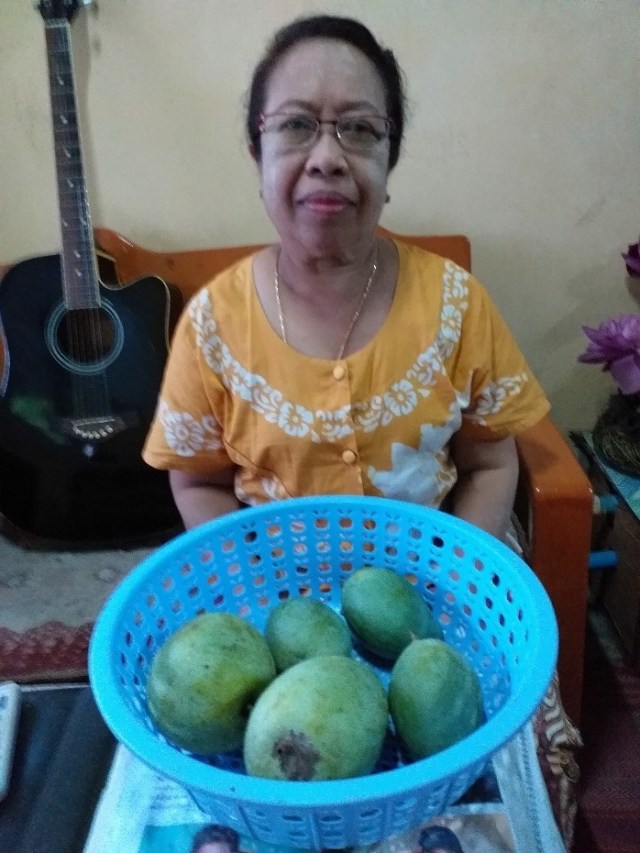
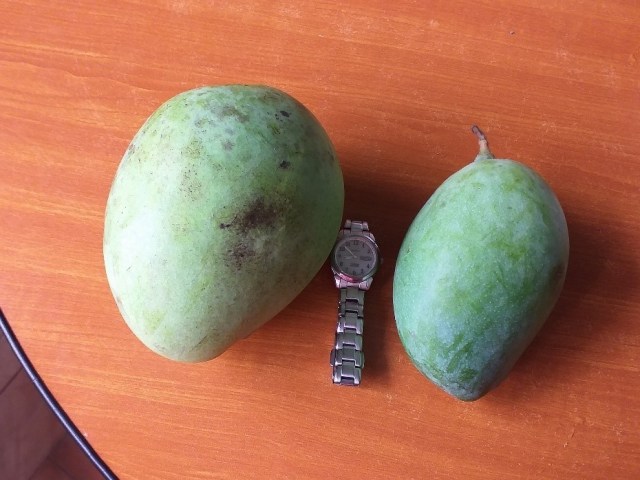
April News from the Yangon Japanese Classroom
30 April 2019
Global Japan Office Coordinator
IMAI Michiko
I escaped Yangon’s intense heat and returned to Japan for a while. After giving a returnee debrief, I had the chance to meet with students from Yangon on exchange at TUFS in the Burmese Language Studies Common Room, which was a six-month reunion for us. The three of are doing very well, and their Japanese has improved a lot. The two female students were always quite good at Japanese, but the male student could only speak broken Japanese when he came to see me last September before he came to Japan. But now, he can have everyday conversations without any trouble. He could also understand my questions when I spoke at my natural speed, and answered them effortlessly. They’ve made so much progress! They are so different from me, who’s spent three years in Yangon and still struggles with everyday conversations.
I asked them about their lives in Japan, but it was difficult summarizing from our conversations, so I interviewed them properly at the end. I interviewed the two girls last fall, but this time I am asking them different questions. I hope you enjoy reading their interview.
H and S are two girls from the Burmese department, and A is a boy from the anthropology department.
Q1. What was your most enjoyable experience in Japan so far?
H: My host family’s Christmas party.
S: When I played in the snow and went snowboarding, and when I stayed on a farm with two foreigners and two Japanese people during my study tour in Idemachi, Yamagata.
A: Spending time at my host family’s house on New Year’s, and flying kites with them in the park.
Q2. What is your favorite Japanese food?
H: Strawberries and Osaka’s Takoyaki
S: High-quality yakiniku (not the buffet type). Also ramen and mochi.
A: I like everything. Especially rice crackers and strawberries.
Q3. What Japanese food do you dislike?
H: Wasabi
S: Wasabi and natto.
A: I don’t have any dislikes.
Q4. What do you dislike about Japan?
H: The fruit is expensive.
S: If you accidentally push up against someone in the train and apologize, people look at you like they’re scared.
A: I like everything about Japan.
Q5. You have 3 months left on your exchange, is there anything you’d like to do before then?
H: I want to keep studying hard.
S: I want to do so many things. I want to study more, and visit places in Tokyo I haven’t been to yet.
A: I want to make more Japanese friends.
Q6. Do you have any advice for students about to go on a one-year exchange?
H: I think it’s good to get a host family.
S: It’s better to study Japanese as much as you can before you come.
(When asked why, S answered that exchange students from the University of Yangon aren’t Japanese majors, and that the content these students do study is very low level).
A: Have fun. Go to places you’ve never even heard of before.
According to this interview, having a host family during your exchange can take a big weight off of your shoulders.
I was surprised that the male student liked all Japanese food including sashimi and natto. Still on the topic of food, I was also a little surprised that both girls said they didn’t like wasabi. Perhaps they don’t like spicy flavors that are different from chili peppers.
Another thing that stood out was how the male student didn’t have any dislikes. I think the Japanese lifestyle suits him a lot. This makes me happy. It’s also impressive how he likes natto, which is practically Japan’s secret weapon.
The three of them seem to be enjoying their lives in Japan to the fullest. I’m envious of how they got to go on an exchange at such a young age. This year abroad will become such a precious experience for them all.
